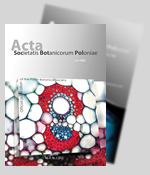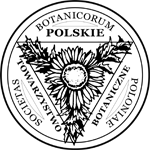Structural Integrity of Vascular System in Branching Units of Coniferous Shoot
Abstract
Keywords
References
Adler, I. (1974). A model of contact pressure in phyllotaxis. Journal of Theoretical Biology, 45(1), 1–79. https://doi.org/10.1016/0022-5193(74)90043-5
Banasiak, A. (2011). Putative dual pathway of auxin transport in organogenesis of Arabidopsis. Planta, 233(1), 49–61. https://doi.org/10.1007/s00425-010-1280-0
Banasiak, A., Biedroń, M., Dolzblasz, A., & Berezowski, M. A. (2019). Ontogenetic changes in auxin biosynthesis and distribution determine the organogenic activity of the shoot apical meristem in pin1 mutants. International Journal of Molecular Sciences, 20(1), Article 180. https://doi.org/10.3390/ijms20010180
Banasiak, A., & Zagórska-Marek, B. (2006). Signals flowing from mature tissues to SAM determine the phyllotactic continuity in successive annual increments of the conifer shoot. Acta Societatis Botanicorum Poloniae, 75(2), 113–121. https://doi.org/10.5586/asbp.2006.014
Barbier, F. F., Lunn, J. E., & Beveridge, C. A. (2015). Ready, steady, go! A sugar hit starts the race to shoot branching. Current Opinion in Plant Biology, 25, 39–45. https://doi.org/10.1016/j.pbi.2015.04.004
Barlow, P. W. (1989). Meristems, metamers and modules and the development of shoot and root systems. Botanical Journal of the Linnean Society, 100(3), 255–279. https://doi.org/10.1111/j.1095-8339.1989.tb01721.x
Bell, A. D. (1991). Plant form: An illustrated guide to flowering plant morphology. Oxford University Press.
Bell, A. D. (1994). A summary of the branching processes in plants. In D. S. Ingram & Hudson (Eds.), Shape and form in plants and fungi (pp. 119–142). Linnean Society of London; Academic Press.
Bhatia, N., & Heisler, M. G. (2018). Self-organizing periodicity in development: Organ positioning in plants. Development, 145(3), Article 149336. https://doi.org/10.1242/dev.149336
Biedroń, M., & Banasiak, A. (2018). Auxin-mediated regulation of vascular patterning in Arabidopsis thaliana leaves. Plant Cell Reports, 37(9), 1215–1229. https://doi.org/10.1007/s00299-018-2319-0
Buchholz, J. T. (1938). Cone formation in Sequoia gigantea. I. The relation of stem size and tissue development to cone formation. II. The history of the seed cone. American Journal of Botany, 25(4), 296–305. https://doi.org/10.1002/j.1537-2197.1938.tb09220.x
Domagalska, M. A., & Leyser, O. (2011). Signal integration in the control of shoot branching. Nature Reviews Molecular Cell Biology, 12(4), 211–221. https://doi.org/10.1038/nrm3088
Dormer, K. J. (1965). Correlations in plant development: General and basic aspects. In W. Ruhland (Ed.), Encyclopedia of plant physiology (Vol. XV/1, pp. 452–491). Springer-Verlag. https://doi.org/10.1007/978-3-642-50088-6_16
Evert, R. F. (Ed.). (2007). Esau’s plant anatomy: Meristems, cells, and tissues of the plant body: Their structure, function, and development (3rd ed.). John Wiley & Sons. https://doi.org/10.1002/0470047380
Fichtner, F., Barbier, F., Feil, R., Watanabe, M., Annunziata, M. G., Chabikwa, T. G., Höfgen, R., Stitt, M., Beveridge, C. A., & Lunn, J. E. (2017). Trehalose 6-phosphate is involved in triggering axillary bud outgrowth in garden pea (Pisum sativum L.). Plant Journal, 92(4), 611–623. https://doi.org/10.1111/tpj.13705
Fink, S. (1984). Some cases of delayed or induced development of axillary buds from persisting detached meristems in conifers. American Journal of Botany, 71(1), 44–51. https://doi.org/10.1002/j.1537-2197.1984.tb12483.x
Hallé, F., Oldeman, R. A. A., & Tomlinson, P. B. (1978). Tropical trees and forests: An architectural analysis. Springer-Verlag. https://doi.org/10.1007/978-3-642-81190-6
Hejnowicz, Z. (1974). Pulsation of domain length as support for the hypothesis of morphogenetic waves in the cambium. Acta Societatis Botanicorum Poloniae, 43(2), 261–271. https://doi.org/10.5586/asbp.1974.025
Kebrom, T. H. (2017). A growing stem inhibits bud outgrowth – the overlooked theory of apical dominance. Frontiers in Plant Science, 8, Article 1874. https://doi.org/10.3389/fpls.2017.01874
Kierzkowski, D., Lenhard, M., Smith, R., & Kuhlemeier, C. (2013). Interaction between meristem tissue layers controls phyllotaxis. Developmental Cell, 26(6), 616–628. https://doi.org/10.1016/j.devcel.2013.08.017
Kolb, V. M. (2005). On the applicability of the principle of the quantity-to-quality transition to chemical evolution that led to life. International Journal of Astrobiology, 4(3–4), 227–232. https://doi.org/10.1017/S1473550405002818
Krokene, P., & Nagy, N. E. (2012). Anatomical aspects of resin-based defences in pine. In G. Fett-Neto & K. C. S. Rodrigues-Corrêa (Eds.), Pine resin: Biology, chemistry and applications (pp. 67–86). Research Signpost Kerala.
Lang, A. (1965). Progressiveness and contagiousness in plant differentiation and development. In W. Ruhland (Ed.), Encyclopedia of plant physiology (Vol. XV/1, pp. 409–423). Springer-Verlag. https://doi.org/10.1007/978-3-642-50088-6_13
Larson, P. R. (1975). Development and organization of the primary vascular system in Populus deltoides according to phyllotaxy. American Journal of Botany, 62(10), 1084–1099. https://doi.org/10.1002/j.1537-2197.1975.tb11774.x
Mason, M. G., Ross, J. J., Babst, B. A., Wienclaw, B. N., & Beveridge, C. A. (2014). Sugar demand, not auxin, is the initial regulator of apical dominance. Proceedings of the National Academy of Sciences of the United States of America, 111(16), 6092–6097. https://doi.org/10.1073/pnas.1322045111
Moreira, X., Zas, R., Solla, A., & Sampedro, L. (2015). Differentiation of persistent anatomical defensive structures is costly and determined by nutrient availability and genetic growth-defence constraints. Tree Physiology, 35(2), 112–123. https://doi.org/10.1093/treephys/tpu106
Namboodiri, K. K., & Beck, C. B. (1968). A comparative study of the primary vascular system of conifers. I. Genera with helical phyllotaxis. American Journal of Botany, 55(4), 447–457. https://doi.org/10.2307/2440574
Pinon, V., Prasad, K., Grigg, S. P., Sanchez-Perez, G. F., & Scheres, B. (2013). Local auxin biosynthesis regulation by PLETHORA transcription factors controls phyllotaxis in Arabidopsis. Proceedings of the National Academy of Sciences of the United States of America, 110(3), 1107–1112. https://doi.org/10.1073/pnas.1213497110
Prusinkiewicz, P., & Lindenmayer, A. (1990). The algorithmic beauty of plants. Springer. https://doi.org/10.1007/978-1-4613-8476-2
Puławska, Z. (1965). Correlations in the development of the leaves and leaf traces in the shoot of Actinidia arguta Planch. Acta Societatis Botanicorum Poloniae, 34(4), 697–712. https://doi.org/10.5586/asbp.1965.048
Raunkiaer, C. (1919). Über Homodromie und Antidromie insbesondere bei Gramineen [On homodromy and antidromy, especially in Gramineae]. Andr. Fred. Høst & søn; Bianco Lunos bogtrykkeri.
Romberger, J. A., Hejnowicz, Z., & Hill, J. F. (1993). Plant structure: Function and development. Springer-Verlag. https://doi.org/10.1007/978-3-662-01662-6
Scarpella, E. (2017). The logic of plant vascular patterning. Polarity, continuity and plasticity in the formation of the veins and of their networks. Current Opinion in Genetics and Development, 45, 34–43. https://doi.org/10.1016/j.gde.2017.02.009
Sinnott, E. W. (1936). The relation of organ size to tissue development in the stem. American Journal of Botany, 23(6), 418–421. https://doi.org/10.1002/j.1537-2197.1936.tb09004.x
Sinnott, E. W. (1960). Plant morphogenesis. McGraw-Hill. https://doi.org/10.5962/bhl.title.4649
Teichmann, T., & Muhr, M. (2015). Shaping plant architecture. Frontiers in Plant Science, 6, Article 233. https://doi.org/10.3389/fpls.2015.00233
Tomlinson, P. B. (1983). Tree architecture: New approaches help to define the elusive biological property of tree form. American Scientist, 71(2), 141–149.
Wardlaw, C. W. (1965). The organization of the shoot apex. In W. Ruhland (Ed.), Encyclopedia of plant physiology (Vol. XV/1, pp. 1027–1044). Springer-Verlag. https://doi.org/10.1007/978-3-642-50088-6_29
Zagórska-Marek, B. (1985). Phyllotactic patterns and transitions in Abies balsamea. Canadian Journal of Botany, 63(10), 1844–1854. https://doi.org/10.1139/b85-259
Zagórska-Marek, B. (1994). Phyllotaxic diversity in magnolia flowers. Acta Societatis Botanicorum Poloniae, 63(2), 117–137. https://doi.org/10.5586/asbp.1994.017
Zagórska-Marek, B. (1995). Morphogenetic waves in cambium and figured wood formation. In M. Iqbal (Ed.), Encyclopedia of plant anatomy: The cambial derivatives (pp. 69–92). Gebrüder Borntraeger.
Zagórska-Marek, B., & Banasiak, A. (2000). Related to phyllotaxis interlocked systems of vascular sympodia and cortical resin canals in Abies and Picea shoots. Acta Societatis Botanicorum Poloniae, 69(3), 165–172. https://doi.org/10.5586/asbp.2000.021
Zagórska-Marek, B., & Hejnowicz, Z. (1980). Discontinuous lines on the radial face of wavy-grained xylem as a manifestation of morphogenic waves in the cambium. Acta Societatis Botanicorum Poloniae, 49(1–2), 49–62. https://doi.org/10.5586/asbp.1980.004
Zagórska-Marek, B., Sokołowska, K., & Turzańska, M. (2018). Chiral events in developing gametophores of Physcomitrella patens and other moss species are driven by an unknown, universal direction-sensing mechanism. American Journal of Botany, 105(12), 1986–1994. https://doi.org/10.1002/ajb2.1200
Zagórska-Marek, B., & Szpak, M. (2008). Virtual phyllotaxis and real plant model cases. Functional Plant Biology, 35, 1025–1033. https://doi.org/10.1071/FP08076
Zagórska-Marek, B., & Szpak, M. (2016). The significance of γ-and λ-dislocations in transient states of phyllotaxis: how to get more from less – sometimes! Acta Societatis Botanicorum Poloniae, 85(4), Article 3532. https://doi.org/10.5586/asbp.3532
DOI: https://doi.org/10.5586/asbp.8915
|
|
|








